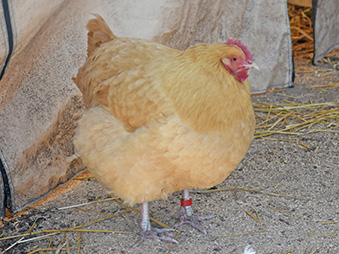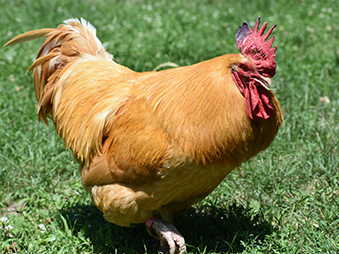Gallus gallus domesticus | Chicken, Orpington Chicken
Names: Curry and Willow (Female)



Meet Willow and Curry, Our Orpington Chickens
Meet Willow and Curry, our charming Buff Orpington chickens—fluffy, friendly, and full of personality. Originally bred in England during the late 1800s, Orpingtons are known for their calm demeanor, striking plumage, and excellent egg-laying skills. Like all domestic chickens, they descend from the red junglefowl of Southeast Asia, but these birds have certainly carved out a royal place in modern backyards and barns.
A Hen-Fever History
Orpington chickens owe their origins to William Cook, a coachman from Orpington, Kent. During the Victorian era’s “Hen Fever”—a craze fueled by Queen Victoria’s passion for exotic poultry—Cook set out to create a practical yet beautiful chicken breed. He wanted a bird that could thrive in England’s cold climate, lay plenty of eggs, and still be fit for the dinner table.
He achieved this by crossbreeding Minorca and Black Plymouth Rocks, then breeding their offspring with clean-legged Langshan. The result? A robust, fast-growing chicken with a soft, dense coat of feathers. His new breed debuted in 1886 and gained international fame by 1896.
Buff and Beyond
Willow and Curry belong to the Buff Orpington variety—known for their sunny golden feathers and docile nature. Buffs became especially popular in the U.S., and today, the American Poultry Association recognizes four official Orpington varieties: Buff, Black, White, and Blue.
Cook didn’t stop at one color—he continued to develop multiple feather patterns and hues, giving chicken enthusiasts a rainbow of fluffy options.
Social, Smart, and Chatty
Orpingtons are intelligent and affectionate birds that enjoy socializing with both their flock mates and their human caretakers. They communicate using a wide variety of clucks, chirps, and squawks. They even form tight bonds and will often follow their favorite people around—like feathery little shadows.
Feeding Time Favorites
Like their junglefowl ancestors, chickens are omnivores (they eat both plants and animals) and natural foragers. Given the chance, they'll peck and scratch for seeds, insects, grasses, and even the occasional small critter. At the zoo, Willow and Curry enjoy a specially formulated game bird chow that gives them the nutrition they need to stay healthy and active.
While many domestic chickens can be raised in free-range settings, our hens live in a protected habitat. This is to keep them safe from Avian Influenza, a virus that poses serious risks to birds worldwide.
Fluffy Ambassadors
Willow and Curry help guests appreciate the heritage and intelligence of domestic animals. They may not be wild or exotic, but they’re an important part of human history and agriculture. Their story also supports responsible animal care and reminds us of the strong connections we can build with animals—even in our own backyards.
Fact Sheet
Taxonomy
Genus: Gallus | Species: gallus | Subspecies: domesticus |
Kingdom: Animalia | Phylum: Chordata | Class: Aves | Order: Galliformes | Family: Phasianidae |
Favorite Enrichment Type
Mirrors, substrates (dirt, sand) to scratch in, bells, and linens to walk on.
Life Span
- In the Wild: (Domesticated)
- In Human Care: 8 to 12 years
Diet
- In the Wild: (Domesticated)
- At the Zoo: Game bird chow
Geographic Range
Native to Southeast Asia.
Habitat
Typically farms in chicken coops or free ranging.
Fun Facts About Orpington chickens
- Nickname: “Buff Beauties”, for Buff Orpingtons.
- Native to: England (originally bred in Orpington, Kent).
- Activity: Diurnal – active during the day.
- Diet: Omnivorous – eats seeds, grasses, insects, and formulated poultry feed.
- Special Features: Fluffy plumage, calm temperament, excellent egg layers, hardy in cold weather.
- Communication: Clucks, squawks, and chirps used to communicate with flockmates.
- Fun Folklore: Part of “Hen Fever,” a Victorian-era obsession with fancy chickens inspired by Queen Victoria!
Status: Not Evaluated (Domesticated)
International Union for Conservation of Nature (IUCN) – Not Evaluated.
How to Find Us
Come visit us at the new Fowl Shack! Located right next to the Rainforest building.
